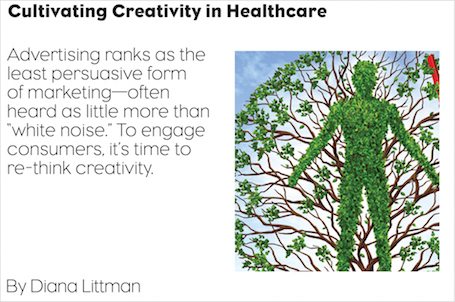What’s the most compelling campaign you’ve ever seen? What viral video really stayed with you? Has a Facebook post ever made you think differently about a brand? When we look at what drives strong emotional connections with a brand’s message, it’s how a story is told. From P&G’s emotional “Thank you, Mom” campaign to breaking down barriers with CoverGirl’s new male “CoverBoy,” stories are what draw people in. And while they can be told in countless ways—from experiential events and print ads, to tweets and Snapchat stories—creativity is what sets memorable, meaningful content apart. And yes, there is creativity in healthcare, but it’s time to up our game.
With people trusting brands less and opting out of advertising more, the same approaches aren’t going to fly. However, not everyone in our industry has adjusted to this new reality. Though advertising continues to rank as one of the least persuasive forms of marketing and Ad Age reported that two out of three Millennials use an ad blocker, digital ad spending is poised to increase worldwide in 2017 (eMarketer).
Pharmaceutical marketers face the challenge of a highly regulated industry and often use this as a reason to curtail creativity. But as DTC spend rises year over year and our audience—patients, caregivers, payers, and HCPs—considers advertising white noise, creativity needs a rethink. Healthcare brands must redefine creativity—going beyond the ever-expected TV spots and print ads—and embrace new ways to address their marketing and business challenges.
When we say “creativity,” we mean two things:
1. The “What”
What is the actual content, message, or output, such as a video, print, or social media post.
2. The “How”
How is the means or channels brands use to get the “what” out there. With increased consumer resistance to traditional paid marketing solutions and brand-sponsored content, influencers—some with thousands or even millions of followers—are being widely leveraged across both consumer and healthcare companies to help brands tell their stories. This isn’t a new concept but, given how many commoditized solutions are popping up every day, an increased level of creativity is absolutely essential for engineering a successful influencer program. And despite the fact that there are countless ways to creatively reach people, healthcare brands keep going back to the same well.
What can we do now to stay relevant, earn loyalty, and turn reluctant consumers into active patients and die-hard advocates? It starts with a new way in.
Moments of Relevance: The New Way In
With so many brands pushing their message out into the world, timing is everything. It may not always be about a moment in time—it can also mean a barrier or trigger that relates to an individual’s state of mind. Here’s what that means:
Case Study
The Challenge: When MMC was tasked with growing Galderma’s aesthetic and corrective brands, timing was key to standing out in a crowded, celebrity-driven marketplace.
The Solution: Zeroing in on a specific time in a woman’s life let us establish a rich, emotional connection.
The Result: Exploring the powerful mother-daughter bond, our #MomGenes social media campaign featured women who recreated their favorite old photos of their mothers. This sparked an honest dialogue about aging, prevention, and treatment options while celebrating what mothers pass down to the next generation—wisdom, love, and the genes that determine aging. By showing how Galderma understood a particular juncture in a woman’s life and her mindset, we established the brand’s credibility and engaged a more receptive audience. We thought beyond paid strategies and honed in on the human insights that made Galderma relevant to their audiences.
My advice to brands is this: Think of who can most effectively, interestingly, and credibly deliver your message, then add scale. Also, by being inherently interesting and relevant, scale may naturally follow.
Embrace a Data-Driven Approach
If creativity is the heart of a successful campaign, data is the brain. And when these two work in conjunction—they are unstoppable. Healthcare brands do use data to understand patients, but not enough in uncovering new approaches to establish connections with them. Data is key to surfacing human insights and behaviors that can spark creative development.
While the pharma industry is slow moving when it comes to adopting innovative strategies, we need to evolve at pace with the rest of the world. Many areas of healthcare and technology are merging to make people’s lives better, easier, healthier—our marketing strategies should be no different.
At a recent pharma industry conference, MMC presented diabetes category research to show how data is instrumental in developing effective programs, and how what works in the consumer space can work in healthcare.
Using data and social listening, our team took a closer look at what people were discussing in the context of diabetes. Some topics were expected, such as nutrition and exercise. Others were more surprising: Massage, shoes, meditation, and dining out. These areas offered a better, less crowded way in for brands to talk about diabetes because people with diabetes were already discussing those topics. Next, we used the data to explore the main concerns of people with diabetes and identify influencers in that field. By connecting all three—the topics, the concerns, and the influencers—we could create unexpected, yet relevant content that drives a behavior change.
Prioritizing Creativity in Recruitment and Culture Building
To do creative work, you need creative thinkers and diversity of perspective and opinion. To do things differently, we need to look beyond healthcare experts. We need people who can invent new ways to approach the healthcare industry’s biggest problems, people who are curious as to why things are happening, not just when or how. They are the ones who make those connections that, at first, don’t seem intuitive but end up bringing a new, more effective approach. Those surprising connections are the cornerstones of memorable, compelling content. Diversity helps to not simply replicate the status quo; different perspectives and fresh approaches pave the way for the kind of first-to-market, breakthrough programs that brands need to resonate and stay relevant today.
To further foster a creative culture, provide incentives and resources that encourage your teams to innovate. Ideas can come from anyone, anywhere—not just your creative agency. Repetition and positive reinforcement of ideas that “break the mold” are crucial to establishing the pillars of a creative culture. While these processes do take time to implement and build, they are important for driving innovation.
Fostering seamless collaboration across the organization and the spectrum of players on both agency and client teams is also key to a successful creative culture. When everyone from strategy to technology and design to legal are aligned on the approach and invested in creativity, their time and resources can then focus on overcoming real obstacles vs. process issues. We can’t ignore the realities and risks of marketing in a highly regulated industry, but we must be nimble and act quickly to stay relevant in people’s lives.
The Need for Change
Why is the need for adopting new levels of creativity so urgent? The marketplace for chronic conditions has become more and more crowded in the last few years. And for rare diseases, where the FDA awarded 354 orphan drug designations out of 472 requests, new market entrants have to reach smaller, hyper-targeted populations more efficiently. So, how do we adapt to meet the needs of patients of the future or prevent them from becoming patients in the first place?
Information is running freely. We need to harness this data from social media and predictive analytics so healthcare marketers can take more calculated risks, explore greater creative opportunities and, ultimately, impact lives for the better.
Looking Ahead
It’s a fact: The challenges that healthcare brands face are not only unique to healthcare, but unique from brand to brand, region to region, and so on. But the reality is, we’re living in an ever-complicated world. With people tuning brand messaging out, we need to focus less on our product and more on how we add value to people’s lives.
Data allows us to gauge and pinpoint a great many things, but without leveraging the human insights and behavior that data also reveals, brands run the risk of ignoring a fundamental ingredient in building innovative, creative programming.
Welcoming these insights, adopting diverse perspectives, and placing a premium on creativity in both content and delivery means brands will not only reach their audience, but will add value to their lives and transform them into advocates.









